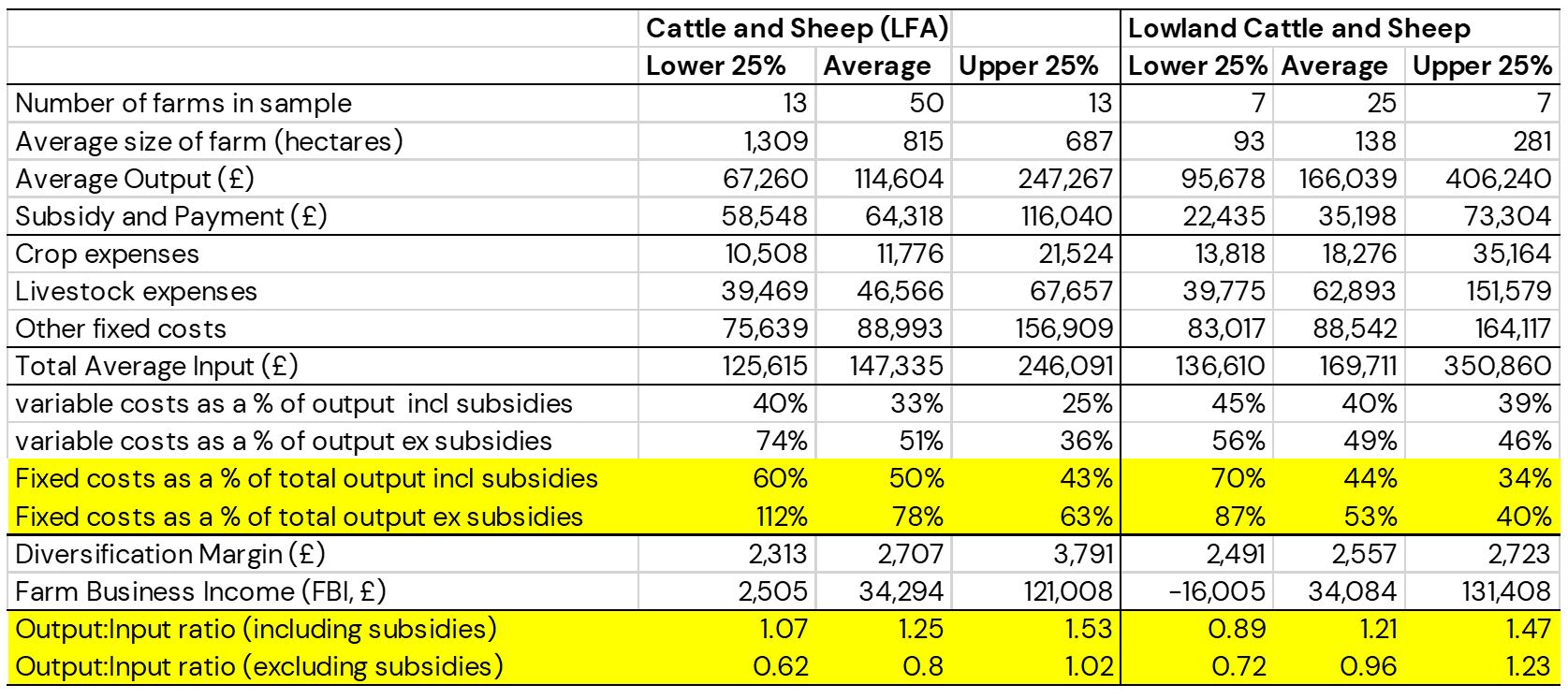How to Reduce Your Fixed Costs
2 June 2023Compare your farm business fixed and variable costs to the group national average of farm businesses similar in size and type to your own. See where you can improve your business performance.
Do you have enough output to support your fixed costs?

Fixed costs aren't 'fixed' - thinking about ways to reduce these as a percentage of output while maintaining productivity can help your profitability.
The latest results from Scottish Farm Business Survey (2021-22) found a 3% (lowland) / 4% (LFA) increase in fixed costs on the year for cattle and sheep farms. For LFA farms this included machinery running costs up by 9%, contractor costs up 40% and land and property up 19%.
The table below shows worrying profitability with only the top 25% of lowland cattle and sheep farms making a profit (Output:Input ratio over 1, more money in than out) when subsidy is excluded and on LFA farms even the top 25% are only breaking even.
Gross output analysis targets for productive profitable agricultural businesses are to have variable costs not exceeding 30-40% of output. The table below shows that many businesses are achieving this but only the top performing 25% of LFA farms are achieving this when subsidy is excluded.
Looking at fixed costs:
- Labour - 7.6% of av. LFA fixed costs
- Machinery - 53%
- Land, property and finance – 27%
These highlight an even starker issue within the industry with fixed costs swallowing up the large majority, or even all, in the case of lower 25% LFA, of output when subsidy is excluded. These figures clearly demonstrate that the upper performing 25% of farms have better control of fixed costs in relation to output.
Table: Extract from the Farm Business Survey Results, 2021-22

Reducing fixed costs
It can seem easier to reduce variable costs such as purchased feed and fertiliser, through practices such as making more from home grown forages, clover rich swards and altering breeding seasons. It may seem harder to make big changes to fixed costs while maintaining productivity.
Fixed costs, however, are far from fixed and can be reduced as a % of output in two ways:
- Reduce total fixed costs:
a) Is your business over mechanised?
b) Do you have high repair and fuel costs?
c) Are you using your labour efficiently? - Increase output/ ha from similar or reduced fixed costs to spread costs over greater output.
One example of the latter is to increase your grassland productivity by:
- Increasing yields: ensure you have optimum soil pH, soil fertility, and species composition.
- Utilisation (rotational grazing) to increase stocking rate and output/ha will spread your fixed costs.
What’s more, by increasing productivity from in-hand acreages, you can reduce reliance on rented/seasonal ground providing the opportunity to reduce total fixed costs by giving up rented ground.
When looking to invest capital, we must be sure that the investment does indeed generate a return and not add to fixed costs in the future. For example, machinery in excess of requirements is a depreciating asset that will add to repair and operating costs. Would we be better investing in our greatest natural assets, soil and pasture, through optimising liming, drainage, fertility and grazing infrastructure to maintain and promote future productivity (output/ha).
We can refine current systems but also, we should look at the potential for alternative systems that may allow substantial reductions in fixed costs. Examples include:
- Outwintering cattle on a forage crop -, this would mean fewer housing and machinery requirements (sell kit - less depreciation, repairs, fuel).
- If a farm isn’t suitable for outwintering, should it have wintering/breeding cattle at all, should a summer store enterprise be run instead? This can offer the opportunity to de-mechanise and rent sheds out, lowering fixed costs and giving an alternative income.
You can see how your fixed costs compare to farm businesses of a similar size and type to your own using the Scottish National group average dataset.
Daniel Stout, SAC Consulting Sheep Specialist
Sign up to the FAS newsletter
Receive updates on news, events and publications from Scotland’s Farm Advisory Service
